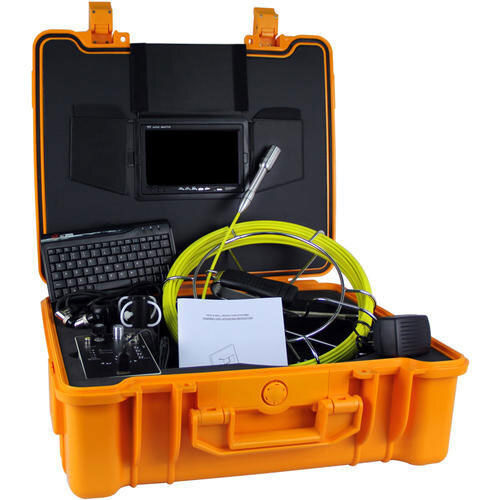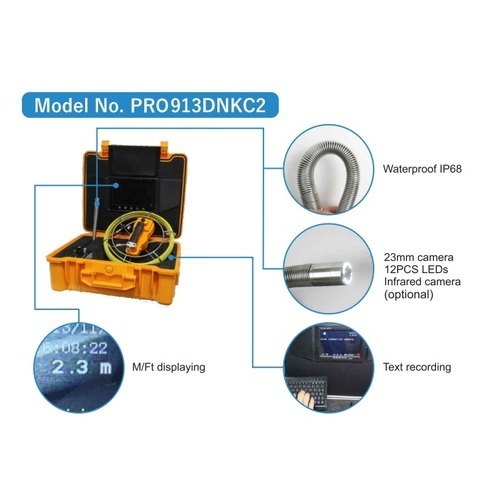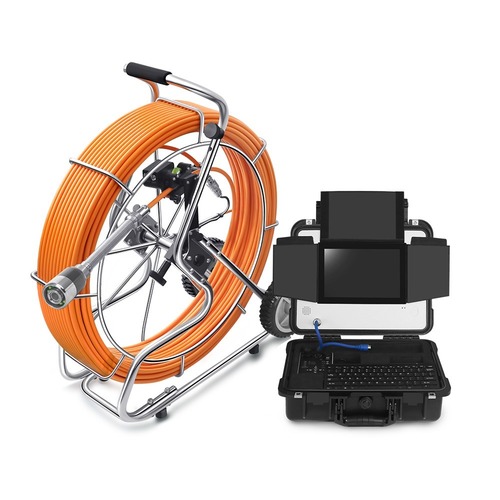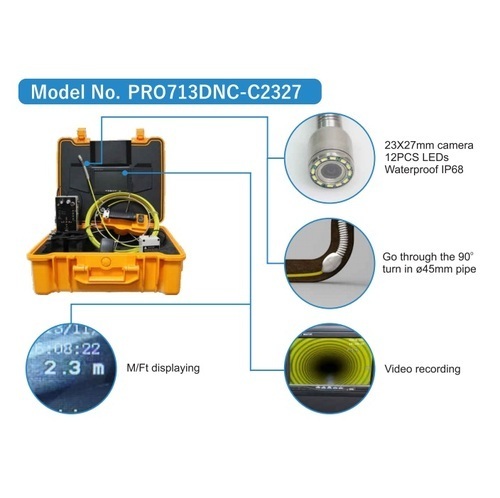Pipeline Inspection Camera
Product Details:
- Usage Industrial
- Power 220V/50Hz
- Size L 520 X W 435 X H 200 mm
- Function Pipeline Inspection, Live Video Display
- Accuracy High Precision
- Product Type Pipeline Inspection Camera
- Operating Mode Manual/Auto
- Click to View more
X
Pipeline Inspection Camera Price And Quantity
- 1 Set
Pipeline Inspection Camera Product Specifications
- Pipeline Inspection Camera
- Remote Control
- High Precision
- Manual/Auto
- L 520 X W 435 X H 200 mm
- 5.9 kg Kilograms (kg)
- Industrial
- Industrial Grade
- Pipeline Inspection, Live Video Display
- Black
- 220V/50Hz
Pipeline Inspection Camera Trade Information
- 7-10 Days
Product Description
A pipeline inspection camera, also known as a sewer inspection camera or a drain camera, is a specialized device used for visual inspection of pipelines, sewer lines, drains, and other confined spaces that are difficult to access. These cameras are equipped with features specifically designed for navigating through pipes and providing high-quality images or videos of the interior conditions.
Here are some key components and features commonly found in pipeline inspection cameras:
1. Camera Head: This is the part of the device that captures images or videos. It is usually mounted on a flexible cable or a push rod to navigate through the pipeline. The camera head may have built-in LED lights to illuminate the surroundings in dark environments.
2. Cable or Push Rod: The camera head is attached to a cable or push rod that allows it to be inserted into the pipeline. These cables or rods are typically flexible and can bend around corners, allowing the camera to inspect the entire length of the pipeline.
3. Monitor or Display: The images or videos captured by the camera are displayed on a monitor or screen in real-time, allowing the operator to see the condition of the pipeline as the inspection is taking place. Some systems may also have the capability to record the footage for later analysis.
4. Control Unit: This is the device used to control the movement of the camera within the pipeline. It may have buttons or joysticks for adjusting the direction and speed of the camera, as well as other features such as zoom and focus control.
5. Recording and Documentation: Many pipeline inspection cameras come with built-in recording capabilities, allowing inspectors to document their findings for further analysis or reporting. Some systems may also have GPS or other location tracking features to record the exact location of any issues found during the inspection.
6. Accessories: Depending on the specific application, pipeline inspection cameras may come with various accessories such as different types of camera heads (e.g., pan-and-tilt, self-leveling), skids or wheels for navigating through different types of pipes, and attachments for retrieving objects or performing repairs.
Uses of Pipeline Inspection Camera:
1. Routine Maintenance and Inspections: Regular inspection of pipelines, sewer lines, and drains is essential for preventive maintenance. Inspection cameras allow professionals to identify potential issues such as blockages, leaks, corrosion, or structural damage before they escalate into larger problems.
2. Locating Blockages: One of the primary uses of pipeline inspection cameras is to locate and identify blockages within pipelines and drains. By inserting the camera into the pipeline, operators can visually inspect the interior and pinpoint the location of any obstructions, such as debris, roots, or buildup.
3. Identifying Structural Issues: Inspection cameras can detect various structural issues within pipelines, including cracks, fractures, joint misalignments, and collapses. Identifying these issues early can help prevent further damage and avoid costly repairs.
4. Assessment of Pipe Condition: Pipeline inspection cameras provide visual documentation of the condition of pipes and sewer lines. This information helps professionals assess the overall health of the pipeline system and prioritize maintenance or repair efforts accordingly.
5. Quality Assurance during Construction: Inspection cameras are used during the construction of pipelines and sewer systems to ensure that installations meet quality standards and specifications. They can identify defects or deficiencies in new installations before they become operational.
6. Environmental Inspections: In environmentally sensitive areas, such as wetlands or protected water bodies, inspection cameras can be used to assess the condition of pipelines without causing disturbance to the surrounding habitat.
7. Forensic Investigations: In cases of pipeline failures or accidents, inspection cameras can be used for forensic investigations to determine the cause of the incident and assess the extent of damage.
8. Utility Mapping and Surveying: Pipeline inspection cameras can assist in mapping underground utility networks by visually inspecting the layout and condition of pipes and conduits.
9. Industrial Applications: Inspection cameras are used in industrial settings to inspect process pipelines, machinery, and equipment for defects, corrosion, or foreign objects.
10. Security Inspections: In security-sensitive areas such as airports, inspection cameras can be used to inspect drainage systems and underground conduits for potential security threats or breaches.
High-Definition Visual Clarity
Equipped with an HD camera (720P/1080P), this inspection system delivers exceptionally clear visuals, allowing users to detect faults and irregularities in pipelines with heightened accuracy. Combined with 12 high-intensity LEDs, the camera provides optimal illumination, ensuring crisp, detailed footage even in challenging, low-light conditions.
Robust and Industrial-Grade Build
Manufactured with a blend of ABS and aluminum alloy, the camera unit is engineered for durability and stability. Its IP68 waterproof rating ensures reliable operation in wet and harsh pipeline environments. With a maximum cable reach of 30 meters, this device supports comprehensive, deep inspections in a wide range of industrial applications.
Efficient Operation and Data Management
Designed for practical use, the camera system features intuitive manual and auto operation modes, managed remotely for convenience and safety. The 7-inch TFT LCD provides real-time video monitoring, while footage can be easily stored on SD cards (up to 32GB), enabling efficient data analysis and reporting for maintenance and diagnostics.
FAQs of Pipeline Inspection Camera:
Q: How does the pipeline inspection camera improve the inspection process?
A: The camera enables non-destructive, real-time inspection with HD video clarity, allowing operators to identify blockages, leaks, or damages deep within pipelines without excavation, saving both time and resources.Q: What storage options are available for recorded inspections?
A: The camera system includes an SD card slot that supports storage capacities up to 32GB, enabling users to save and transfer large video files and inspection reports for future review and detailed assessment.Q: When should this inspection camera be used in industrial applications?
A: This device is optimal for scheduled maintenance, troubleshooting, and routine pipeline surveys across industries such as water supply, sewage, oil, and gas to ensure infrastructure integrity and prevent costly failures.Q: Where can the pipeline inspection camera be effectively deployed?
A: Thanks to its 20-30 meter cable and robust waterproof construction, the camera is suitable for use in underground pipelines, industrial plants, municipal infrastructure, and other hard-to-reach or submerged environments.Q: What are the usage methods for controlling the device during inspections?
A: Users can manipulate the camera via manual controls or opt for the automatic mode, both accessible through the included remote control, facilitating flexible and safe operation during inspection tasks.Q: What benefits does the IP68 waterproof rating provide?
A: The IP68 rating ensures the camera remains fully operational when submerged or exposed to high-moisture environments, greatly extending its reliability and service life in demanding industrial conditions.Tell us about your requirement

Price:
Quantity
Select Unit
- 50
- 100
- 200
- 250
- 500
- 1000+
Additional detail
Mobile number
Email
 English
English Spanish
Spanish French
French German
German Italian
Italian Chinese (Simplified)
Chinese (Simplified) Japanese
Japanese Korean
Korean Arabic
Arabic Portuguese
Portuguese






 Call Me Free
Call Me Free
